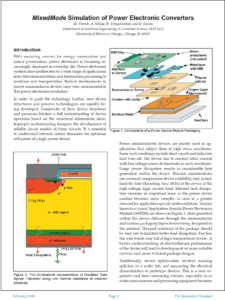MixedMode Simulation of Power Electronic Converters
Introduction
With mounting concern for energy conservation and nature preservation, power electronics is becoming increasingly dominant in everyday life. Power electronics systems have proliferated to a wide range of applications from telecommunications and information processing to medicine and transportation. Radical developments in power semiconductor devices have been instrumental in this power electronics revolution.
In order to push the technology further, new device structures and process technologies are rapidly being developed. Complexity of these device structures and processes hinders a full understanding of device operation based on the structural information alone. Improper understanding hampers the development of reliable circuit models of these circuits. It is essential to understand internal carrier dynamics for optimum utilization of a high power device.
Power semiconductor devices are mostly used in applications that subject them to high stress conditions. Some such conditions include short circuit and inductive load turn-off. The device has to conduct rated current with bus voltage across its terminals in such conditions. Large power dissipation results in considerable heat generation within the device. Thermal considerations can seriously compromise device reliability, and, in fact, limit the Safe Operating Area (SOA) of the device at the high-voltage, high-current limit. Efficient heat dissipation becomes an important issue as the power device module becomes more complex to cater to a greater demand for application specific system solution. Various layers in a typical Application-Specific Power Electronics Module (ASPEM) are shown in Figure 1. Heat generated within the device diffuses through the semiconductor and various packaging layers before being dissipated in the ambient. Thermal resistance of the package should be very low to facilitate better heat dissipation. Further, the wire bonds may fail at high temperature levels. A better understanding of electrothermal performance of the device will lead to development of more reliable devices and more efficient package designs.



